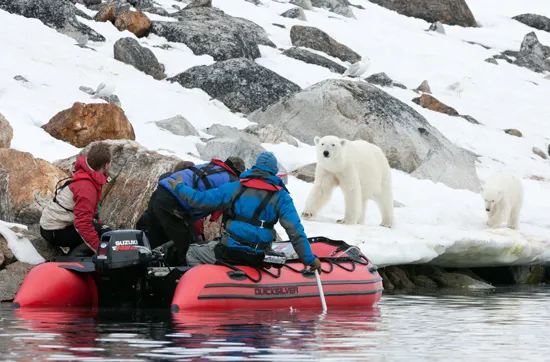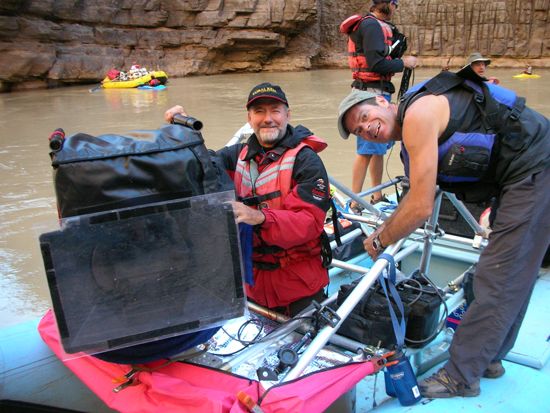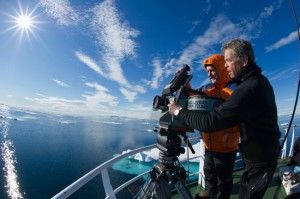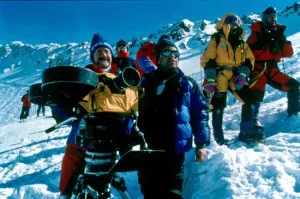Film vs. Digital: The IMAX Edition
Filmmaker Greg MacGillivray discusses imminent changes to the IMAX format
/https://tf-cmsv2-smithsonianmag-media.s3.amazonaws.com/filer/20120411040043IMG-3247.jpg)
Opening Friday, April 20, To the Arctic 3D is the 35th IMAX documentary from MacGillivray Freeman Films. Narrated by Meryl Streep and with songs by Paul McCartney, the film examines how polar bears and other Arctic wildlife are struggling with climate change. But the real draw to the film is the astonishing cinematography by Greg MacGillivray and his crew.
The foremost name in large-format filmmaking, MacGillivray Freeman has been making IMAX documentaries for over 35 years. It is the first documentary production company to earn a billion dollars in box-office receipts. The company began in the late 1960s when surfing fanatics Greg MacGillivray and Jim Freeman pooled resources to work on documentaries and commercials. They gained a reputation for aerial photography after their 1971 short about Mexico, Sentinels of Silence, won two Oscars.

The company won a commission from the Smithsonian Institution to make a large-format film about aviation as the opening attraction at the National Air and Space Museum (and to tie-in with the nation’s bicentennial). To Fly!, the second highest-grossing large format film of all time, is still regularly screened at the museum. (Jim Freeman died in a helicopter accident two days before the premiere of To Fly!)

With titles like Everest, The Living Sea, and Hurricane on the Bayou, MacGillivray Freeman not only helped legitimize the IMAX process, it helped establish a new audience for films. Dozens of museums and educational facilities have built IMAX theaters, and large-format wildlife documentaries have become a right of passage for a generation of schoolchildren. “And IMAX is growing by leaps and bounds in developing countries,” MacGillivray adds. “Particularly China. In five years there will be over 200 IMAX theaters in China.”
Large-format filmmaking requires different skills than those for feature films and television. “The shots are longer, and you’re shooting wider—wider lenses and wider scenes so that the audience experiences the material in a kind of interactive way,” MacGillivray told me by phone last week from his Los Angeles offices. “In a normal movie, the director controls what you look at. The shots don’t last very long because you’re getting the audience to look at specific things. An IMAX shot, on the other hand, can be twenty or thirty seconds long. The audience has time to look around the frame, see the birds flying in the distance, a flock of geese coming overhead, the wind whipping up in the background. The viewers aren’t manipulated, they’re experiencing it on their own terms.”

The opening shots of To the Arctic 3D, a majestic aerial view of a glacial shelf complete with calving icebergs, puts MacGillivray’s theories into practice. The images have a startling beauty and clarity, and patient filmmaking gives viewers time to appreciate them fully.
The director is coming to grips with inevitable changes to the IMAX process. IMAX offers both film and digital projection systems. Digital is required for 3D projection, but it won’t reach 4K resolution for another two years or so. And according to MacGillivray, 4K is necessary to duplicate the IMAX experience on film.
Most IMAX theaters in museums are film based, and will remain so for at least three or four years. “It will be bad if theaters change over to digital before the quality is there,” MacGillivray believes. “The films could lose their audience.”
MacGillivray still shoots on film for 70 percent of the time, even though an IMAX magazine holds enough for only three minutes of footage. Plus it can take ten minutes to load a new magazine when you’re working in sub-zero temperatures. “That becomes tricky when shooting wildlife,” MacGillivray points out. “You have to plan when you will be reloading.”
Why work in such a cumbersome process? “When you’re capturing on IMAX 15/70 film, you’re getting ten times the resolution of the highest form of digital today,” MacGillivray says. “4K digital, for example, is about 12 million pixels per frame, and IMAX in 15/70 film is over 120 million—some say 150 million— pixels per frame.”
MacGillivray hopes the digital process will eventually reach 8K, at which point it could duplicate or even better the resolution from the film system. But there will still be differences in how each process looks on screen.

The film image, for example, is built from grain that forms when silver halide particles are exposed to light. MacGillivray explains that the grain particles form a random pattern. “Grain isn’t structured like a screen door that you’re looking through, but pixels are. Film-based grain is just all over the place, one frame totally different from the next. So your edges are coolly sharp and have a different feeling, an organic feeling rather than this mechanic feeling you get with digital. A lot of people relate it to the difference between vinyl music and digital music.”
Another difference between film and digital: “Film has far more color shades. It’s called bit depth in digital terms. And most bit depth in digital is about twelve, but film bit depth can be twenty to thirty. And so you just have more shades of yellow and red and oranges and everything. You can get extra shades of color with digital if you had more storage, but then you’re defeating the chief advantage of the process because everything would get bigger and more expensive.”
If the color, organic look, and smoothness of film are superior to digital, why switch processes? “With digital you do have the advantage of having an absolutely rock steady image because there’s no projector gate, no perforations, no film weaving through a machine. And there’s no dust, and no scratching.”
MacGillivray also finds digital easier to work with, “a lot easier until something goes wrong. And then you have to close down for two days so an expert can come in.”
To the Arctic 3D is being presented through the One World One Ocean Foundation. Founded by MacGillivray and his wife Barbara, this new initiative is intended to raise awareness to ocean issues through IMAX and feature films, television specials, YouTube videos, and other social media. The director cites the work of Jacques Cousteau, who in the 1960s would broadcast as many as three or four ocean-related television specials a year. “The ocean needs a voice in the entertainment base, and we’re going to try to bring the same continuity of effort that Cousteau did some 40 years ago,” he says.
Read about how astronauts were trained to use IMAX cameras on the space shuttle on our Around the Mall blog.
/https://tf-cmsv2-smithsonianmag-media.s3.amazonaws.com/accounts/headshot/daniel-eagan-240.jpg)
/https://tf-cmsv2-smithsonianmag-media.s3.amazonaws.com/accounts/headshot/daniel-eagan-240.jpg)